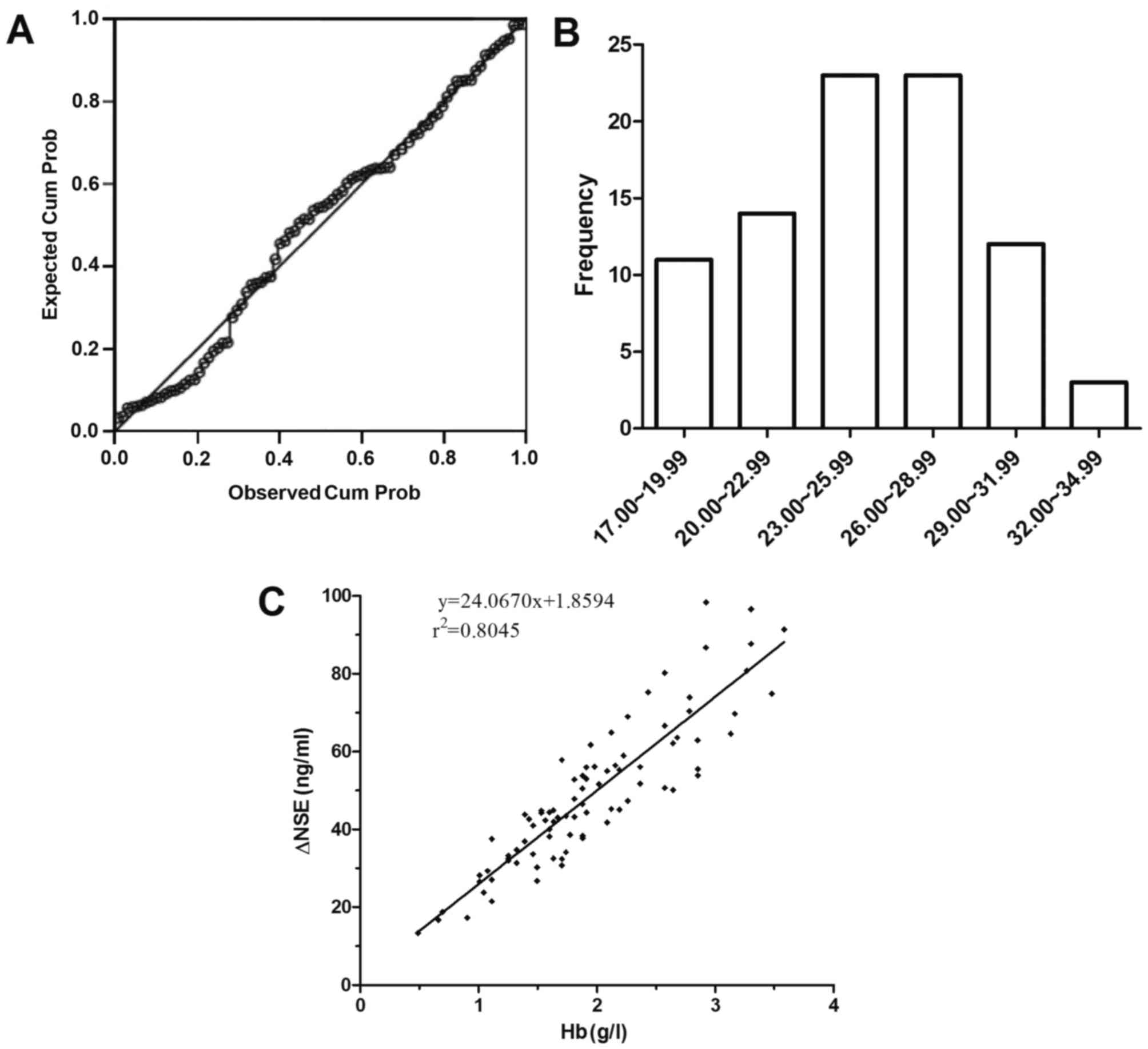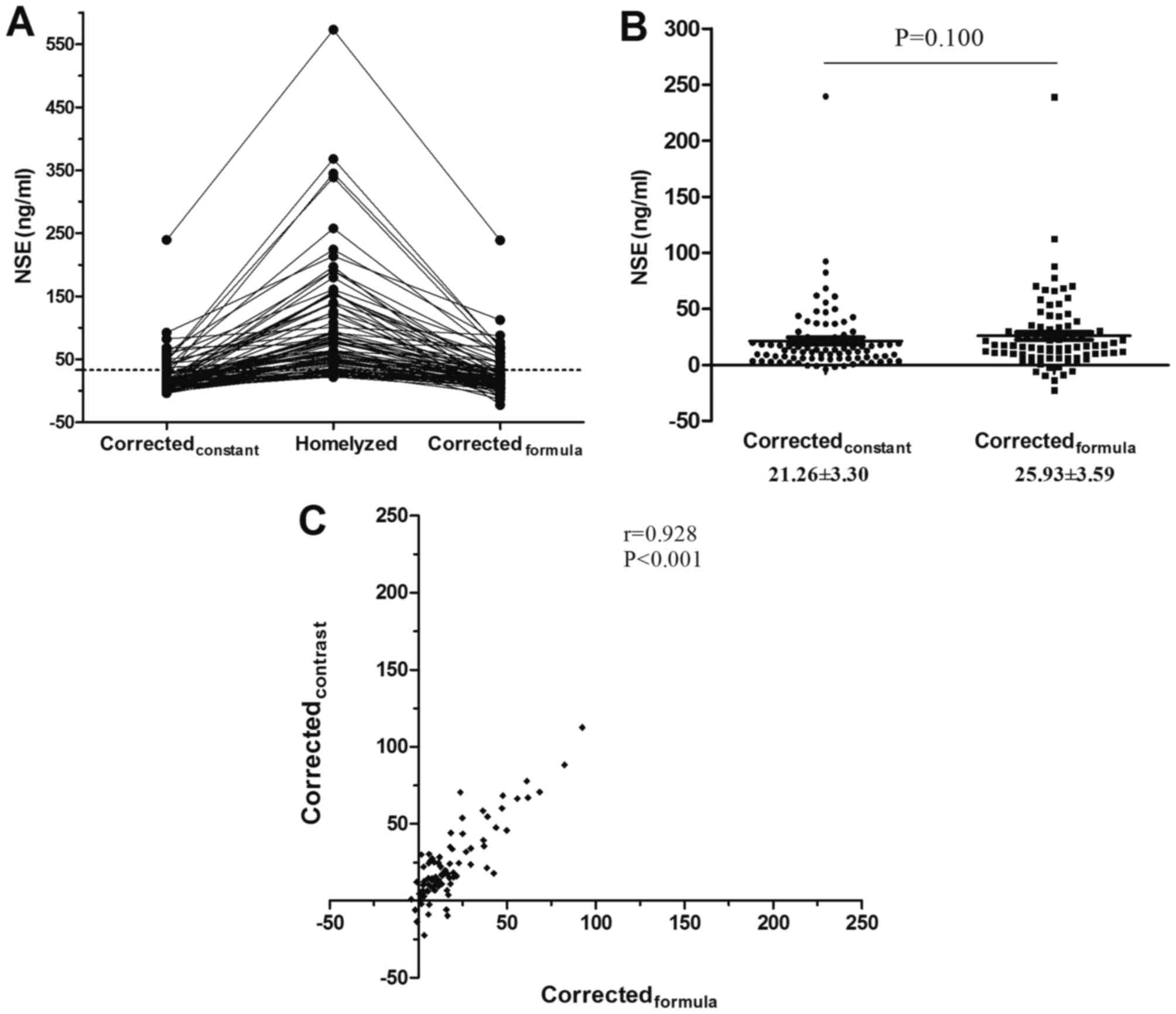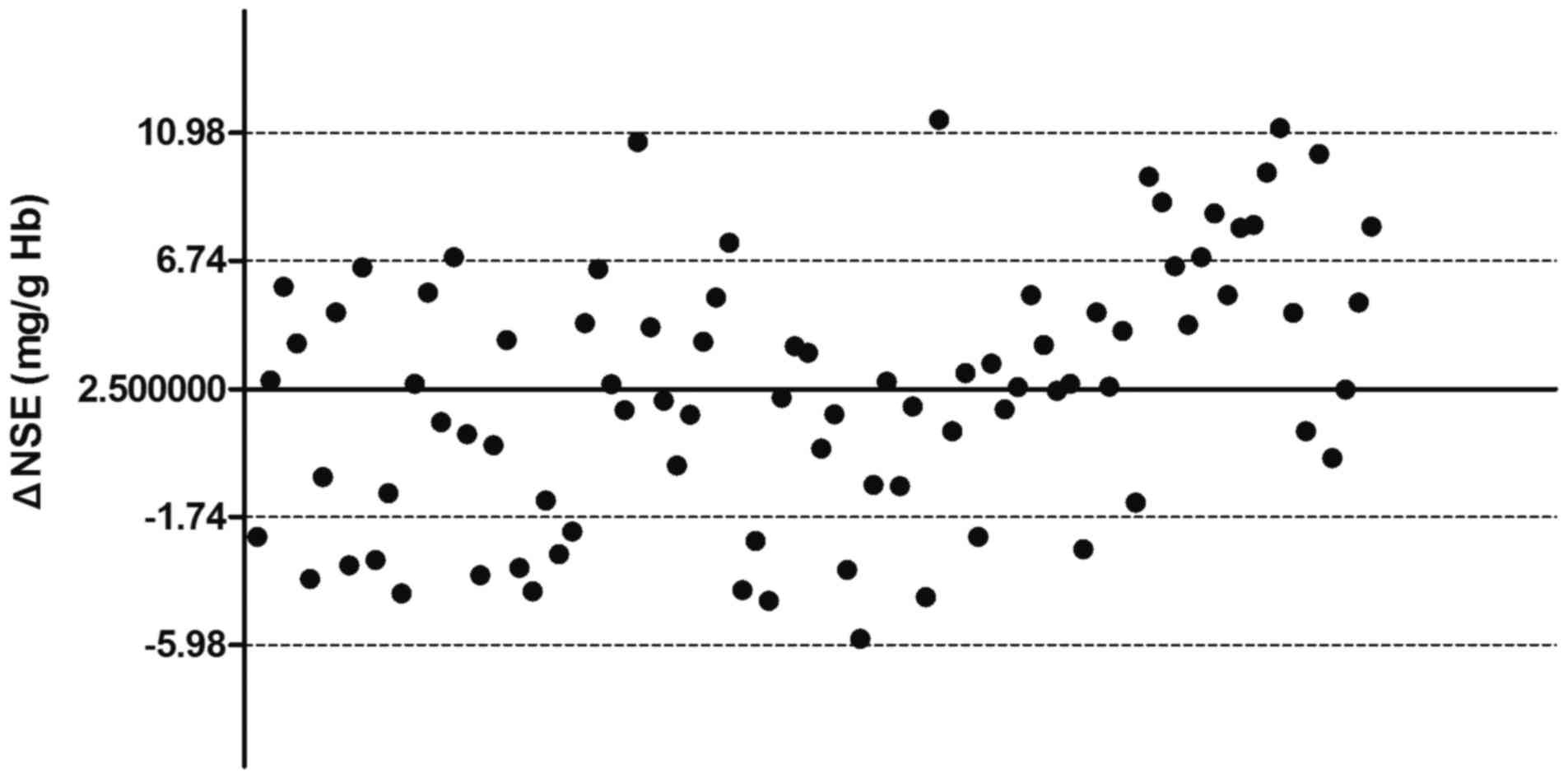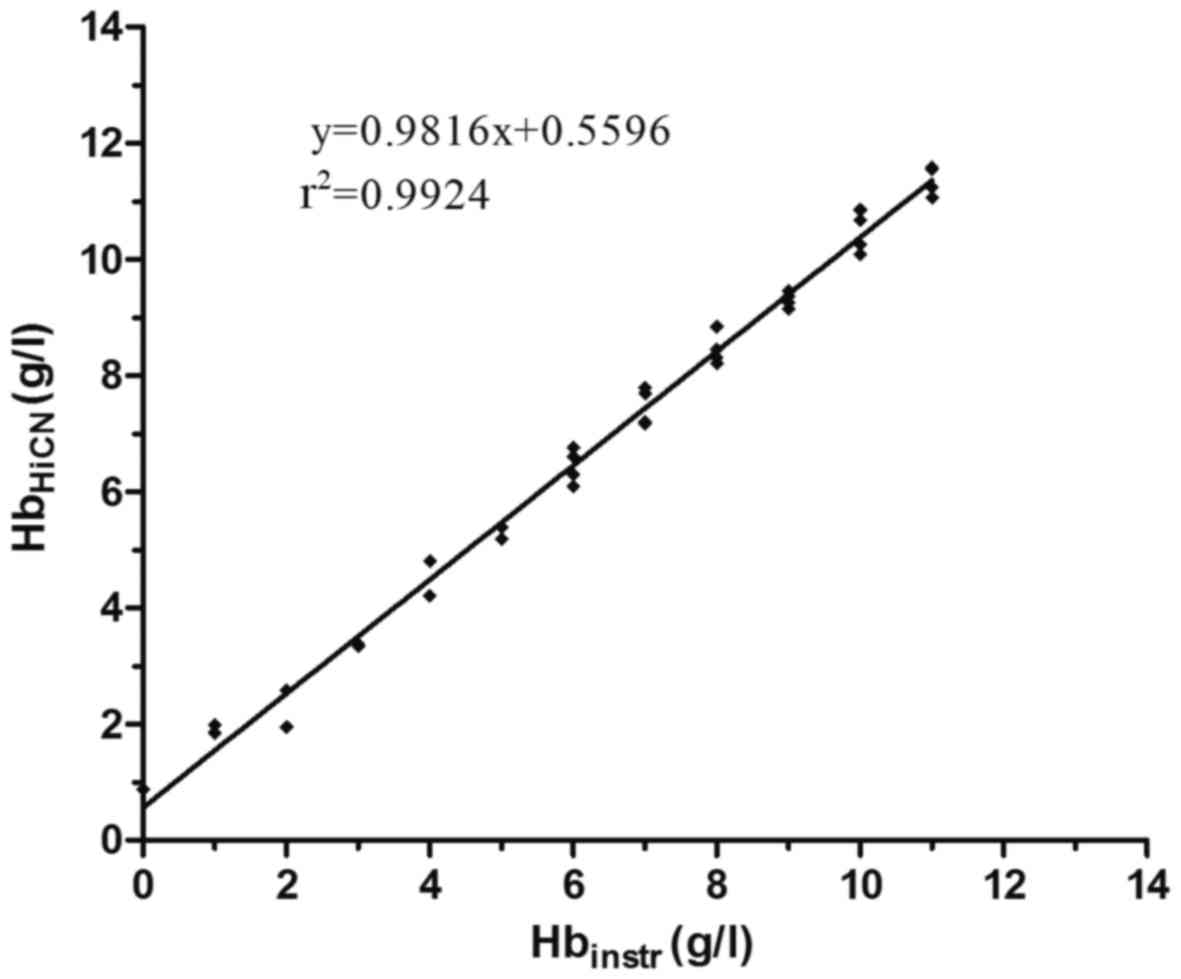A correction formula for neuron‑specific enolase measurement in hemolyzed neonatal serum samples
- Authors:
- Published online on: March 21, 2018 https://doi.org/10.3892/br.2018.1081
- Pages: 491-496
Abstract
Introduction
Hypoxic-ischemic encephalopathy (HIE) secondary to perinatal asphyxia remains a major cause of neonatal mortality and morbidity worldwide (1,2). The incidence of HIE ranges from 1 to 3 per 1,000 full-term infants and is present in almost 60% of premature newborns (3–5). Approximately 15–20% of affected newborns succumb within the postnatal period, and an additional 25% develop severe and permanent neuropsychological handicaps, including cerebral palsy, seizures, visual impairment, mental retardation, learning disabilities and epilepsy (5).
Neuron-specific enolase (NSE) belongs to the family of enolase enzymes present in all tissues and organisms capable of glycolysis (6). Enolases consist of three subunits (α, β, and γ) encoded by separate genes. These subunits may combine to form five different isoenzymes: αα, αβ, αγ, ββ and γγ (6). NSE, comprised of γγ homodimers and αγ heterodimers, is widely distributed in central nervous system neurons and amine precursor uptake and decarboxylation cells (7). As a marker of neuronal cell death, the serum concentration of NSE is associated with the degree of HIE and may be used to evaluate the severity and outcome of HIE (8–11). According to receiver operating characteristic curves, serum concentrations of NSE above 40 mg/l obtained between 4 and 48 h after birth may distinguish infants with no or mild HIE from infants with moderate or severe HIE; additionally, serum concentrations of NSE at a cut-off value of 45.4 mg/l may distinguish infants with poor outcomes from infants with normal outcomes (11).
NSE is present in substantial levels in the brain and at lower levels in platelets, red blood cells (RBCs) and the kidney, and may be differentiated from non-neuronal enolase (NNE), which is present in substantial levels in the brain, liver, lung, muscle, testis and platelets and at lower levels in RBCs, through the use of targeted immunoassays (12). As platelets and RBCs contain NSE, hemolyzed samples cannot be tested for NSE. However, neonatal blood specimen collection is prone to hemolysis due to the relatively small size of blood vessels in newborns, and repeated blood sampling is difficult to perform. Therefore, the present study investigated the effect of neonatal serum hemolysis on the detection of NSE and whether the use of a correction formula may aid to reduce these effects.
Materials and methods
Study subjects
A total of 86 serum samples were collected from newborns, including 54 males and 32 females, within 24 h of birth at the Affiliated Hospital of North Sichuan Medical College (Nanchong, China) between March 2015 and October 2015. Total bilirubin results of 588 newborns (375 males and 213 females) within 120 h of birth, and the time of phlebotomy time after the birth of 530 newborns (328 males and 202 females) for NSE detection, were collected retrospectively at the Affiliated Hospital of North Sichuan Medical College between March 2015 and July 2015. The hemoglobin (Hb) content of blood samples from 280 newborns (163 males and 117 females), recruited from the Affiliated Hospital of North Sichuan Medical College between March 2015 and May 2015, were measured within 24 h of birth and classified into different levels to understand the distribution characteristics of total bilirubin, phlebotomy time following birth for NSE detection and Hb content in neonatal serum samples. All samples were tested for corresponding assays within 2 h of collection.
Hb standard curve for hemolyzed neonatal serum samples
Absorbance values at 540 nm of a standard solution of Hb (Tianjin Institute of Modern High-Tech Research Center, Tianjin, China) at concentrations of 50, 100, 150 and 200 g/l were measured in a UV-Vis spectrophotometer (Beijing Purkinje General Instrument Co., Ltd., Beijing, China). A standard curve for whole blood was established by plotting the absorbance values versus the Hb content. The whole-blood samples of 10 randomly selected newborns (n=280 group) were mixed; 20 µl of this mixed blood sample was added to 5 ml Van Kampen and Zijlstra solution (Tianjin Institute of Modern High-Tech Research Center), and the absorbance value of the mixture was measured at 540 nm within 5–15 min at room temperature. The Hb content of the mixed whole-blood samples was obtained using the standard curve for whole blood. Concentrations of Hb of 2, 4, 6 and 8 g/l were diluted in physiological saline; 100 µl of this diluted sample was added to 2.5 ml Van Kampen and Zijlstra solution, and the absorbance values of the mixture were also measured at 540 nm within 5–15 min. A standard curve for the hemolyzed neonatal serum samples was established by plotting the absorbance values versus the Hb concentration, and the standard curve was used to calculate the Hb concentration in the neonatal serum samples (n=86).
Hemolyzed neonatal serum NSE quantitation
Whole-blood samples were collected from newborns (n=86)within 24 h of birth, and the sera were isolated by centrifugation at 2,583 × g and 25°C for 5 min. The NSE values were measured in serum samples by LIAISONXL chemiluminescence analyzer (DiaSorin S.p.A., Saluggia, Italy) with LIAISON® NSE kit (314561; DiaSorin S.p.A.). For each sample, 200 µl RBCs were drawn into a tube, stored frozen at −80°C for 5 min, and thawed completely at room temperature; the freeze-thaw cycle was repeated three times. From each sample tested, 300 µl serum was drawn into another tube and mixed with 10 µl treated RBCs. Serum was isolated by centrifugation at 2,583 × g and 25°C for 5 min after mixing, and the NSE results of hemolyzed neonatal serum samples were measured by chemiluminescence.
Hemolyzed neonatal serum Hb quantitation
Samples of 100 µl hemolyzed neonatal serum for which NSE concentrations had been determined prior to and following addition of freeze-thawed RBCs were added to 2.5 ml Van Kampen and Zijlstra solution. Absorbance values of the mixtures were measured at 540 nm within 5–15 min, and Hb concentrations were calculated according to the Hb standard curve for hemolyzed neonatal serum samples.
Correlation of hemoglobin cyanide (HiCN) and instrument tests
As described in the National Committee for Clinical Laboratory Standards EP9-A2 document (13), the Hb concentrations of 40 randomly selected hemolyzed neonatal serum samples (n=530 group) within 24 h of birth with different degrees of hemolysis (Hb: 0.50 g-12.00 g/l) were measured with the HiCN method and a Hb analyzer. The correlation was evaluated between the test results of these two methods.
Statistical analysis
SPSS version 18.0 (SPSS, Inc., Chicago, IL, USA) was used to establish the result database and perform the statistical analyses. Measurement data were expressed as the mean ± standard deviation. The normality of the individual constant between neonatal serum NSE levels relative to the Hb concentration was evaluated by P-P plot and D'Agostino's test. The Mann-Whitney U test was adopted to compare corrected NSE levels between the individual constant group (n=86) and the group following correction formula application (n=86), and total bilirubin levels between a ‘within 24 h of birth group’ (n=181) and ‘within 25–120 h of birth group’ (n=407). The Pearson test was utilized for correlation analysis between the adjusted values of the two groups. The Pearson test and linear regression analysis were used to compare the correlation between the levels determined by the HiCN and instrumental methods. P<0.01 was considered to indicate statistical significance.
Results
Laboratory and clinical features of neonatal serum samples
As presented in Table I, the content of serum total bilirubin in newborns within 25–120 h of birth was significantly higher compared with that in newborns within 24 h of birth (P<0.01). When NSE was detected, the birth time of the newborn was mainly distributed within 24 h. However, the serum samples of newborns within 24 h of birth appeared to be hemolyzed, and the concentration of Hb in most sera was >2 g/l.
Standard curves of Hb
The standard curve of the Hb concentration in whole blood was Hbblood=371.6900×A540nm+1.7835 (r=0.9991) according to the colorimetric analysis of a standard solution. In hemolyzed neonatal serum samples, the standard curve was Hbserum=34.7690×A540nm+0.2492 (r=0.9996).
Correlation between the changes in concentrations of Hb and NSE
The individual constant of NSE for hemolyzed neonatal serum samples was the ratio between the change of NSE to the Hb content in hemolyzed neonatal serum samples prior to and following addition of individually frozen-thawed RBCs of newborns. The individual constants of NSE in the 86 hemolyzed neonatal serum samples were 25.15±3.94 mg/g Hb. Based upon the P-P plot analysis, the individual constants of NSE were normally distributed (Fig. 1A and B); the same result was obtained with D'Agostino's test (P=0.314; data not shown). The changes in the concentration of NSE in sera prior to and following addition of individually frozen-thawed RBCs were significantly correlated with the changes in the concentration of Hb (Fig. 1C); the correlation of concentration variation between NSE and Hb in hemolyzed neonatal sera was ΔNSEserum=1.8594+24.0670×HbHiCN (r2=0.8045, P<0.001).
Comparison of the NSE results corrected by two different correction methods
The corrected NSE results from the individual constant group and correction formula group were compared with hemolyzed serum NSE results (Fig. 2A). There was no statistically significant difference in corrected NSE results between the individual constant and correction formula groups (Z=−1.645, P=0.100; Fig. 2B). Additionally, the results demonstrated that the corrected NSE results from the individual constant group were significantly correlated with those of the correction formula group (r=0.928, P<0.001; Fig. 2C). The 95% confidence interval results for NSE corrected with the formula were in the range of −5.98–10.98 mg/g Hb, which were comparable with the results of NSE corrected by individual constants (Fig. 3).
Correlation between HiCN and instrument tests
The concentration of Hb in hemolyzed serum samples was measured by the HiCN and instrumental methods. The content of Hb measured by the HiCN method was significantly correlated with that measured by the instrumental method (Fig. 4); the linear regression formula of Hb measured by the instrumental method compared with HiCN was Hbinstr=0.9816×HbHiCN+0.5596 (r2=0.9924, P<0.001).
Correction formulas
According to the association between the changes in NSE and Hb content in neonatal serum, as well as the correlation between the two methods for the determination of Hb, the correction formulas for the determination of NSE in hemolyzed neonatal serum were NSEcorr=NSEmeas-24.0670×HbHiCN-1.8594 and NSEcorr=NSEmeas-24.5181×Hbinstr+11.8609.
Discussion
The present study described the effect of hemolysis on the quantitative results of NSE in hemolyzed neonatal serum and proposed a correction formula for the quantitative results of NSE in hemolyzed neonatal serum. The correction formula cannot be applied to all newborns, particularly those with serum samples collected more than 24 h after birth, and cannot achieve true NSE results in hemolyzed neonatal sera. However, compared with the quantitative results of NSE or the estimated results of NSE based upon the pediatrician's experience with hemolyzed neonatal sera, the corrected NSE results were closer to the true value, and thus have potential in aiding pediatricians to evaluate the presence, severity and prognosis of HIE, particularly for newborns within 24 h of birth.
Due to differences in metabolism and half-life, investigating the association between the changes of NSE and Hb in vivo and the occurrence of physiological hemolysis in newborns is difficult, particularly during the period of large-scale metabolic conversion of Hb to bilirubin in the reticuloendothelial system of the liver, spleen and marrow (14,15). Not only the association between the changes of NSE and Hb needs to be considered, but also the association between the changes of Hb and bilirubin. The corrected NSE results may be far from the true results. The degree of hemolysis of erythrocytes and the concentration of bilirubin in the serum of newborns exhibits a sharp increase on the third day and a slight decrease on the fifth day of birth (16). Accordingly, in the current study, the quantitation of total bilirubin in the serum of newborns within 24 h was higher compared with that in newborns aged 2 to 5 days old. This finding demonstrates that neonatal physiological hemolysis may occur or that Hb metabolic conversion may occur after 24 h. In addition, more than 90% of clinical orders to measure NSE in serum were made within 24 h of the neonate's birth; and for more than 80% of newborns born within 24 h, their degree of hemolysis of sera was greater than 1 g/l Hb. These investigations demonstrate that i) establishing a correction formula for NSE in serum of newborns born within 24 h may account for most neonates; ii) establishing a correction formula for NSE in serum for newborns is critical; and iii) in most cases, a new blood sample from newborns obtained within 24 h of birth may improve the situation of hemolysis. Perinatal HIE involves two distinct phases: Immediate primary neuronal death associated with cellular hypoxia and depletion of energy stores; and a secondary phase of delayed neuronal death (at approximately 6 h) associated with reperfusion injury (17). Establishing correct judgment and treatment is critical for the prognosis of newborns with HIE before 6 h of life (18). Overall, the present study established a correction formula for NSE in serum obtained from newborns within 24 h of birth.
Photometric determination of HiCN is recommended as the standard method for the quantitative determination of Hb in blood. If any other method is used, it should be compared with the HiCN method (19). In addition, when a spectrophotometer is used, the blood should be appropriately diluted (for example, 1:251, 20 µl blood in 5 ml reagent) (19). In the current study, because of the low level of Hb in neonatal sera, the dilution ratio was reduced (1:26, 100 µl serum in 2.5 ml reagent) to increase the sensitivity of HiCN in quantitating Hb in neonatal serum samples, and a best fit line of the concentration of Hb was obtained with the optical density at λ=540 nm and an r2=0.9996.
The reference range of NSE in neonatal serum in our laboratory is 0.00–18.00 mg/l, determined from NSE data when NSE testing was performed at our laboratory, and the range of inter-individual variability of NSE with Hb is 25.15±3.94 mg/g Hb. This observation indicates that more than 80% of newborns may have different degrees of misinterpretation of their NSE results, particularly when the pediatrician does not consider the effect of hemolysis on the results of NSE. When verifying the performance of the correction formula, the concentration of NSE in all 86 hemolyzed neonatal serum samples exceeded the upper limit of the normal range prior to correction; in comparison, the ratios for exceeding the upper limit of the normal range were 34.88 and 44.19% for corrections by individual constants and the correction formula, respectively. There was no significant difference between those two groups of correction results, and thus the correction formula may be used to correct the concentration of NSE in hemolyzed neonatal sera. However, it should be highlighted that approximately 64, 31 and 5% of corrected results for NSE may exhibit a maximum difference of 6.74, 10.98 and greater than 10.99 mg/g Hb, respectively, although these results were comparable with the results of NSE corrected by individual constants.
Due to the complexity of the HiCN method for detecting Hb in the serum of newborns, correlation analysis was used to evaluate the degree of consistency of the HiCN with an instrumental method, and the results indicated a high degree of correlation (r2=0.9924) between the methods. The instrument method could be used to quantify Hb in the serum of newborns, followed by the concentration of NSE with the correction formula. However, there was a maximum difference of 1 g/l Hb between the two methods, equivalent to an approximately 25.86 mg/l NSE difference, regardless of the degree of hemolysis in the serum of newborns.
In conclusion, the use of a correction formula aided to reduce the effects of hemolysis on NSE results. The present data suggested that the corrected NSE results were closer to the true value and may aid pediatricians evaluate the presence, severity and prognosis of HIE, particularly for newborns within 24 h of birth.
Acknowledgements
The authors are thankful to Professor Xiaobing Tian from North Sichuan Medical College (Nanchong, China) for his assistance with the data analysis.
Funding
The current study was supported by grants from the Department of Science and Technology of Sichuan Province (grant no. 2016JY0171), and the International Science and Technology Cooperation Program of China (grant no. 2015DFA30420).
Availability of data and materials
The datasets used and/or analyzed during the current study are available from the corresponding author on reasonable request.
Author's contributions
QW and GW collected subjects, performed the experiments of Hb quantitation, neonatal serum NSE quantitation and correlation tests for the 86 neonatal serum samples, and prepared and wrote the first draft of this paper. XL performed statistical analyses and edited the manuscript. XG, QD and FL reviewed total bilirubin resultsand clinical order time and edited the manuscript. QF and GZ performed the Hb quantitation of the 280 neonatal serum samples. DW planned and designed the study. All authors read and approved the final manuscript.
Ethical approval and consent to participate
This research programme was approved by the Ethics Committee of the Affiliated Hospital of North Sichuan Medical University and was consented by the parents or guardians of participants enrolled for the purposes of the current study.
Consent for publication
Consent for publication of relevant data was obtained from the parents or guardians of enrolled participants on the basis of anonymization of all personal data.
Competing interests
The authors declare that they have no competing interests.
Glossary
Abbreviations
Abbreviations:
|
HIE |
hypoxic-ischemic encephalopathy |
|
NSE |
neuron-specific enolase |
|
Hb |
hemoglobin |
|
HiCN |
hemoglobin cyanide |
|
RBCs |
red blood cells |
References
|
Douglas-Escobar M and Weiss MD: Hypoxic-ischemic encephalopathy: A review for the clinician. JAMA Pediatr. 169:397–403. 2015. View Article : Google Scholar : PubMed/NCBI | |
|
Agut T, León M, Rebollo M, Muchart J, Arca G and Garcia-Alix A: Early identification of brain injury in infants with hypoxic ischemic encephalopathy at high risk for severe impairments: Accuracy of MRI performed in the first days of life. BMC Pediatr. 14:177–183. 2014. View Article : Google Scholar : PubMed/NCBI | |
|
Pierrat V, Haouari N, Liska A, Thomas D, Subtil D and Truffert P: Groupe d'Etudes en Epidémiologie Périnatale: Prevalence, causes, and outcome at 2 years of age of newborn encephalopathy: Population based study. Arch Dis Child Fetal Neonatal Ed. 90:F257–F261. 2005. View Article : Google Scholar : PubMed/NCBI | |
|
Filippi L, Fiorini P, Daniotti M, Catarzi S, Savelli S, Fonda C, Bartalena L, Boldrini A, Giampietri M, Scaramuzzo R, et al: Safety and efficacy of topiramate in neonates with hypoxic ischemic encephalopathy treated with hypothermia (NeoNATI). BMC Pediatr. 12:144–154. 2012. View Article : Google Scholar : PubMed/NCBI | |
|
Shang Y, Mu L, Guo X, Li Y, Wang L, Yang W, Li S and Shen Q: Clinical significance of interleukin-6, tumor necrosis factor-α and high-sensitivity C-reactive protein in neonates with hypoxic-ischemic encephalopathy. Exp Ther Med. 8:1259–1262. 2014. View Article : Google Scholar : PubMed/NCBI | |
|
Douglas-Escobar M and Weiss MD: Biomarkers of hypoxic-ischemic encephalopathy in newborns. Front Neurol. 3:1442012. View Article : Google Scholar : PubMed/NCBI | |
|
Tolan NV, Vidal-Folch N, Algeciras-Schimnich A, Singh RJ and Grebe SK: Individualized correction of neuron-specific enolase (NSE) measurement in hemolyzed serum samples. Clin Chim Acta. 424:216–221. 2013. View Article : Google Scholar : PubMed/NCBI | |
|
Berger RP: The use of serum biomarkers to predict outcome after traumatic brain injury in adults and children. J Head Trauma Rehabil. 21:315–333. 2006. View Article : Google Scholar : PubMed/NCBI | |
|
Guzel A, Er U, Tatli M, Aluclu U, Ozkan U, Duzenli Y, Satici O, Guzel E, Kemaloglu S, Ceviz A, et al: Serum neuron-specific enolase as a predictor of short-term outcome and its correlation with Glasgow Coma Scale in traumatic brain injury. Neurosurg Rev. 31:439–444; discussion 444–445. 2008. View Article : Google Scholar : PubMed/NCBI | |
|
Chabok SY, Moghadam AD, Saneei Z, Amlashi FG, Leili EK and Amiri ZM: Neuron-specific enolase and S100BB as outcome predictors in severe diffuse axonal injury. J Trauma Acute Care Surg. 72:1654–1657. 2012. View Article : Google Scholar : PubMed/NCBI | |
|
Celtik C, Acunaş B, Oner N and Pala O: Neuron-specific enolase as a marker of the severity and outcome of hypoxic ischemic encephalopathy. Brain Dev. 26:398–402. 2004. View Article : Google Scholar : PubMed/NCBI | |
|
Marangos PJ, Campbell IC, Schmechel DE, Murphy DL and Goodwin FK: Blood platelets contain a neuron-specific enolase subunit. J Neurochem. 34:1254–1258. 1980. View Article : Google Scholar : PubMed/NCBI | |
|
National Committee for Clinical Laboratory Standards (NCCLS): Method Comparison and Bias Estimation Using Patient Samples; Approved Guideline-Second EditionNCCLS document EP9-A2. NCCLS; Wayne, PA: 2002 | |
|
Nakajima H, Takemura T, Nakajima O and Yamaoka K: Studies on hemo α-methenyl oxygenase. I. The enzymatic conversion of pyridine-hemichromogen and hemoglobin-haptoblobin into a possible precursor of biliverdin. J Biol Chem. 238:3784–3796. 1963.PubMed/NCBI | |
|
Robinson SH and Koeppel E: Preferential hemolysis of immature erythrocytes in experimental iron deficiency anemia: Source of erythropoietic bilirubin formation. J Clin Invest. 50:1847–1853. 1971. View Article : Google Scholar : PubMed/NCBI | |
|
Richards JE, Goldbloom RB and Denton RL: Physiologic hyperbilirubinemia and hemolysis of erythrocytes by hydrogen peroxide solution in the newborn: Investigation of a possible relationship. Pediatrics. 20:92–97. 1957.PubMed/NCBI | |
|
Gulczyńska E and Gadzinowski J: Therapeutic hypothermia for neonatal hypoxic-ischemic encephalopathy. Ginekol Pol. 83:214–218. 2012.(In Polish). PubMed/NCBI | |
|
Horn AR, Swingler GH, Myer L, Linley LL, Raban MS, Joolay Y, Harrison MC, Chandrasekaran M, Rhoda NR and Robertson NJ: Early clinical signs in neonates with hypoxic ischemic encephalopathy predict an abnormal amplitude-integrated electroencephalogram at age 6 hours. BMC Pediatr. 13:52–62. 2013. View Article : Google Scholar : PubMed/NCBI | |
|
No authors listed: International committee for standardization in haematology. Recommendations for haemoglobinometry in human blood. Br J Haematol. 13:71–75. 1967. View Article : Google Scholar : PubMed/NCBI |













